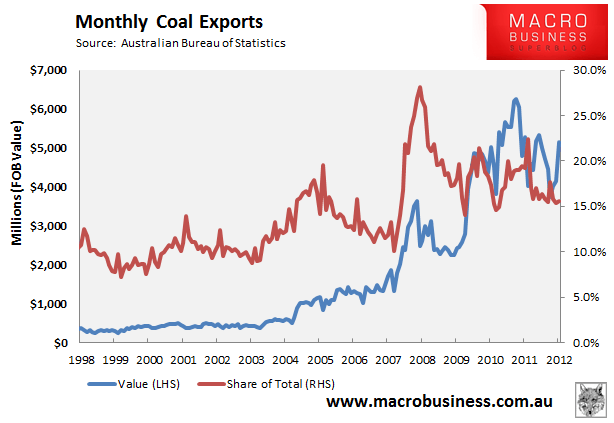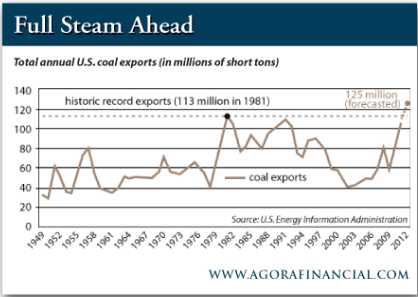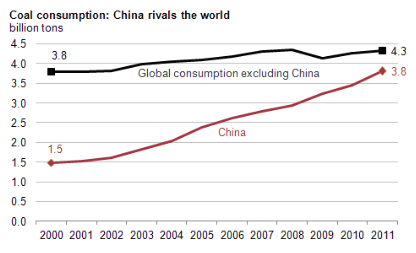
For decades, coal was a linchpin of Australia’s export base. Prior to the China-led commodity boom, coal exports – both thermal and coking – accounted for between 10% and 15% of Australia’s total merchandise exports. And until late-2009, coal was also Australia’s biggest export commodity, only recently ceding its advantage to iron ore, courtesy of China’s fixed asset investment splurge in the wake of the Global Financial Crisis (GFC).
Despite falling to second place on the export rankings, the value of coal exports, as well as coal’s export share, has grown considerably since 2004, as Australia’s once-in-a-century commodity boom gathered pace (see next chart).

However, stiff headwinds could be building on both the supply and demand-side, which threaten to suck the steam out of Australian coal exports.
As noted previously, the US shale gas boom pushed down US natural gas prices to 10-year lows last spring. Unwanted at home, surplus US coal is being redirected into the seaborne export market, which is adding to supplies and depressing prices globally. In fact, 2012 set the all-time record for US coal exports — 125 million short tons, surpassing the previous record of 113 million short tons set in 1981 (see next chart).

To date, most of these exports seem to have headed to Europe, where it is displacing more expensive gas as a feedstock for power stations. According to the Financial Times, US coal exports to Europe increased by 29%, sending European coal prices plummeting from $130 a tonne in March 2011 to around $86 currently.
Locally, thermal coal prices have also taken a hit, with the benchmark Newcastle coal price falling by around 20% over the past year (see next chart).

There are also doubts over whether European coal demand will hold-up. New solar and wind capacity is coming on stream and ageing coal plants are being shut down amid heightened environmental concerns, with EU environmental policy calling for a 20% reduction in carbon emissions from 1990 levels by 2020, as well as a growing role for solar, wind and biomass in electricity generation.
Concerns are also rising in China about the nation’s addiction to coal-fired electricity generation. As noted last week, China is now burning nearly as much coal as the rest of the world combined (see next chart).

The problem is, pollution levels rocketed recently to 40-times recommended safe levels in many of China’s bigger cities, leaving many Chinese literally choking on smog (click to see photos). China’s Government responded with a series of temporary emergency measures such as shutting down 103 heavily polluting factories and taking 30% of government vehicles off the roads, but air quality has remained hazardous.
Public discontent also appears to be brewing. The Beijing News recently published an article demanding that a ‘Clean Air Act’ be enacted to “clarify the responsibilities of the national government at all levels, companies and the individual in air pollution control”. In a similar vein, thousands of Beijing residents have seemingly had enough and called for a Clean Air Act in an online vote on Sina Weibo, according to Xinhua News Agency.
The growing pollution problems in China are likely to cause a gradual shift away from coal fired electricity generation towards cleaner fuel sources, which could ultimately dampen demand for Australian coal at the same time as US coal exports are on the rise.

